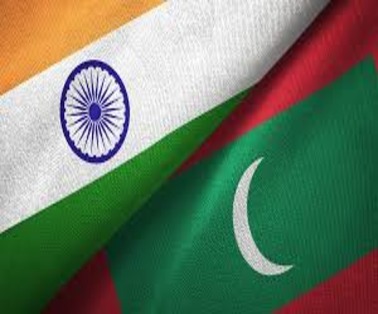India and Maldives conducted the 4th Defence Cooperation Dialogue (DCD) in Male
Key Points
- The dialogue was co-chaired by Defence Secretary Shri Giridhar Aramane and his Maldivian counterpart, Chief of Defence Force, Maldives National Defence Forces Major General Abdulla Shamaal.
- This DCD is the highest institutionalised interactive mechanism between the two countries.
- Its significance in chartering the future course of relations between both the Armed Forces was highlighted by the importance given to the talks by the two nations.
Discussions
- During the interaction, ongoing bilateral defence cooperation activities were reviewed and both sides expressed satisfaction at the increasing engagements.
- The talks covered the existing bilateral exercises, with both countries agreeing to increase the complexity of these drills.
- The Armed Forces of India & the Maldives continue to seek bilateral cooperation in multiple fields and the increased engagements are a positive sign for the future of bilateral relations.
Significance

India and Maldives Relations: History
- India and Maldives share ethnic, linguistic, cultural, religious and commercial links steeped in antiquity and enjoy close, cordial and multi-dimensional relations.
- India was among the first to recognise Maldives after its independence in 1965 and to establish diplomatic relations with the country.
- India established its mission at the level of CDA in 1972 and resident High Commissioner in 1980.
- Maldives opened a full fledged High Commission in New Delhi in November 2004, at that time one of its only four diplomatic missions worldwide.
India and Maldives Relations: Political Relations
- Bilateral relations have been nurtured and strengthened by regular contacts at the highest levels. Since establishment of diplomatic relations, almost all the Prime Ministers of India visited the Maldives.
- On international issues Maldives had consistently supported India in multilateral fora, such as the UN, the Commonwealth, the NAM and the SAARC.
- Maldives was one of the first countries to convey its support for the candidature of Shri Kamalesh Sharma as the Commonwealth Secretary General. Maldives also co-sponsored the G-4 draft resolutions on UN reforms.
- India has extended support to Maldives candidature for a non-permanent seat in the UN Security Council for the term 2019-20.
India and Maldives Relations: Bilateral Trade
- Bilateral Trade India and Maldives signed a trade agreement in 1981, which provides for export of essential commodities.
- India is Maldives 2nd largest trading partner – rising up from its 4th position in 2018.
- In 2021, bilateral trade registered a growth of 31% over the previous year – overcoming the pandemic-related challenges.
- A Bilateral USD Currency Swap Agreement between RBI and Maldives Monetary Authority was signed on 22 July 2019
India And Maldives Relations: Infrastructure Projects:
- Hanimaadhoo International Airport Development project under an Indian credit line will add a brand-new terminal to cater to 1.3 million passengers a year.
- In 2022, the National College for Policing and Law Enforcement (NCPLE) was inaugurated by India’s External Affairs Minister.
- NCPLE is the largest grant project executed by India in Maldives
India And Maldives Relations: Security Partnership
- Defence cooperation extends to the areas of Joint Exercises – “Ekuverin”, “Dosti”, “Ekatha” and “Operation Shield” (begun in 2021).
- India provides the largest number of training opportunities for Maldivian National Defence Force (MNDF), meeting around 70% of their defence training requirements
India And Maldives Relations: Tourism
- Tourism is the mainstay of Maldivian economy. The country is now a major tourist destination for some Indians and a job destination for others.
- In August 2021, Afcons, an Indian company, signed a contract for the largest-ever infrastructure project in Maldives which is the Greater Male Connectivity Project (GMCP).
Maldives
- It is a low-lying island country in the north-central Indian Ocean.
- Its closest neighbours are India, about 600 kilometres north-east, and Sri Lanka, about 645 kilometres north-east.
- It consists of a chain of about 1,200 small coral islands and sandbanks (some 200 of which are inhabited), grouped in clusters, or atolls.
- The islands extend more than 510 miles (820 km) from north to south and 80 miles (130 km) from east to west.
- Its capital is Male
- The official language is an Indo-European language called Dhivehi (or Maldivian). Arabic, Hindi, and English are also spoken.
- Islam is the state religion.
- It revolves mainly around tourism.
- The constitution of the Maldives was adopted in 2008.
To Download Monthly Current Affairs PDF Click here
Click here to get a free demo
Everything About CLAT 2025



